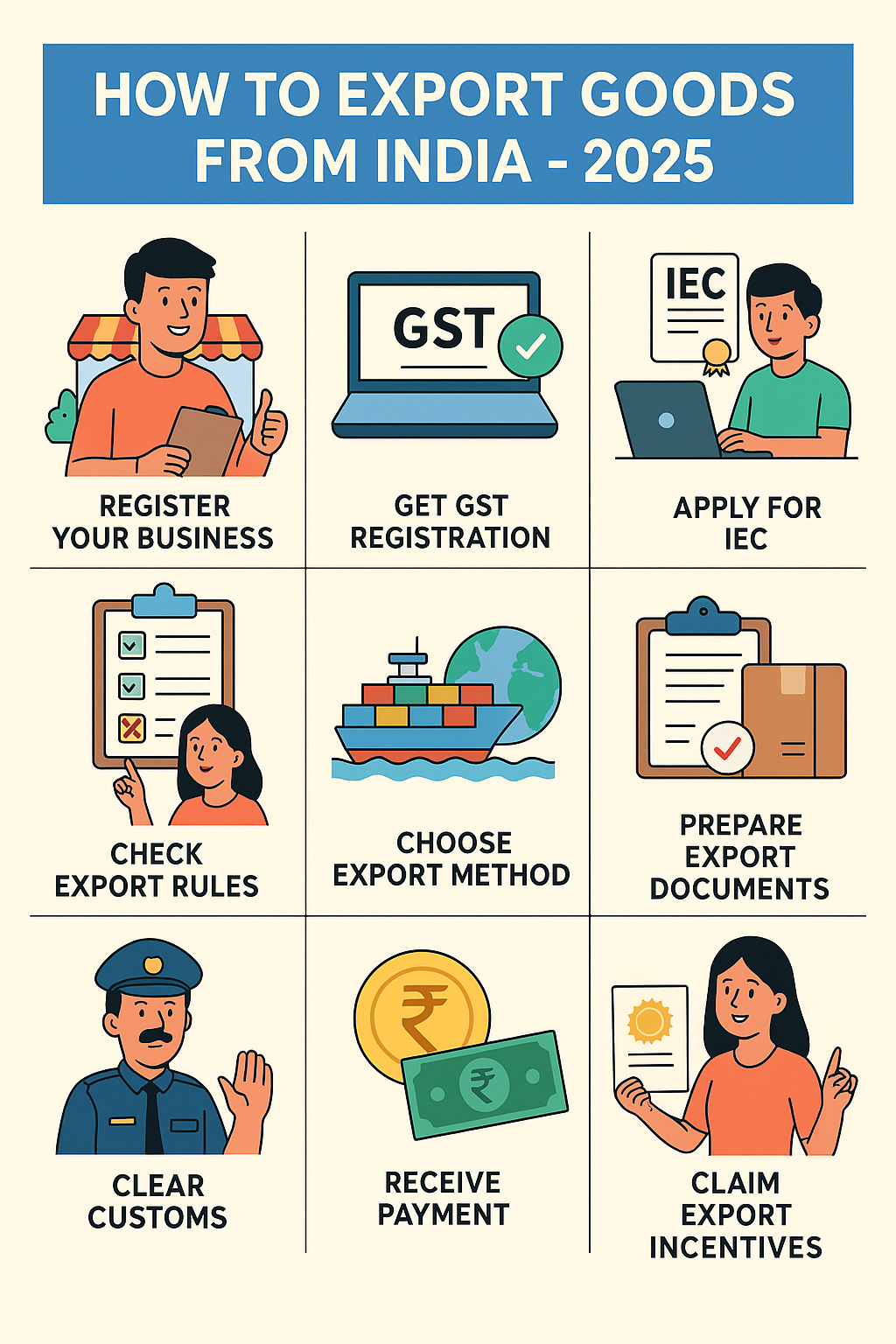Exporting goods from India can give your business global exposure and open new markets. However, it is important to follow Indian export regulations and comply with documentation, customs, and banking rules to avoid delays or penalties.
Here’s a complete, detailed step-by-step guide to start Export Goods from India 2025.
Table of Contents
Step 1 – Register Your Business Legally
Before exporting, ensure your business is registered under Indian law.
Common business structures:
- Sole Proprietorship – Simple setup for small traders.
- Partnership Firm – For businesses with multiple owners.
- LLP (Limited Liability Partnership) – Liability protection with simple compliance.
- Private Limited Company – Best for scalability and international trade.
Tip:
If you plan large-scale exports or want to deal with corporate buyers abroad, a Private Limited Company is often preferred for credibility.
Step 2 – Obtain GST Registration
- GST Registration is mandatory for most exporters in India.
- Under GST, exports are treated as zero-rated supplies under Section 16 of the IGST Act.
- This means you can export without paying GST or pay GST and claim a refund.
Options for Exporters under GST:
- Export under Bond/LUT (Letter of Undertaking) without paying IGST.
- Pay IGST on exports and claim a refund later.
Reference: Rule 96A of CGST Rules, 2017.
Step 3 – Get Your Import Export Code (IEC)
- Issued by DGFT (Directorate General of Foreign Trade).
- Mandatory for any business involved in import or export of goods.
- Lifetime validity, no renewal required.
How to Apply:
- Visit https://dgft.gov.in/
- Fill out the IEC application form (ANF 2A).
- Upload documents:
- PAN Card
- Address Proof
- Bank Details
- Pay the prescribed fee.
- Receive IEC in 1–2 working days.
Step 4 – Check Product-Specific Export Rules
Before exporting, check if your goods are:
- Prohibited – Cannot be exported at all (e.g., certain wildlife items, banned chemicals).
- Restricted – Requires special DGFT license.
- Free – Can be exported without restriction.
Certifications You May Need:
- BIS – Bureau of Indian Standards for manufactured goods.
- AGMARK – For agricultural produce.
- FSSAI – For food exports.
- Phytosanitary Certificate – For plant products.
- APEDA Registration – For agricultural and processed food exports.
Tip: Always check the latest ITC-HS Code classification before exporting.
Step 5 – Choose Your Export Method
You can export goods in two main ways:
- Direct Export –
- You find foreign buyers directly.
- You manage logistics, customs, and payment.
- More control, higher profit margins.
- Indirect Export –
- You sell goods to an export house, merchant exporter, or via online marketplaces like Amazon Global, Etsy, Alibaba.
- They handle export formalities.
- Less effort but lower margins.
Step 6 – Prepare Complete Export Documentation
Mandatory Documents:
- Commercial Invoice – Price, quantity, terms of trade.
- Packing List – Details of packaging & weight.
- Shipping Bill / Bill of Export – Filed via ICEGATE.
- Bill of Lading / Airway Bill – Transport document issued by carrier.
- Certificate of Origin – For trade agreements & duty benefits.
- Insurance Certificate – Protects against loss or damage.
- Export Declaration Form (EDF) – RBI compliance.
Optional/Additional Documents:
- Inspection Certificate
- Phytosanitary Certificate
- Quality Certificate (if required by buyer)
Step 7 – Customs Clearance & Shipping Process
1. File Shipping Bill:
- Through ICEGATE (Indian Customs EDI Gateway).
- Attach invoices, packing list, and IEC details.
2. Customs Inspection:
- Goods are examined to ensure they match declaration.
3. Pay Export Duty (if applicable):
- Most goods have zero export duty, but some (like iron ore) have export tariffs.
4. Hand Over to Freight Forwarder:
- Your goods are shipped by sea, air, or courier.
Tip:
Use CHA (Customs House Agent) if you are new to exports to avoid paperwork errors.
Step 8 – Payment & Bank Compliance Export Goods from India 2025
- Use safe payment methods like:
- Letter of Credit (LC)
- Advance Payment
- Documentary Collection
- Under FEMA regulations, export proceeds must be realized within 9 months from the date of shipment.
- Submit the Bank Realization Certificate (BRC) to DGFT for claiming benefits.
Step 9 – Claim Export Incentives
The Indian government offers benefits to encourage exports:
- RoDTEP (Remission of Duties and Taxes on Export Products) – Refund of taxes/duties.
- Advance Authorization Scheme – Duty-free import of raw materials.
- EPCG Scheme – Duty-free import of capital goods.
- TMA Scheme – Transport subsidy for agricultural products.
Tip:
Register on the DGFT portal to apply for incentives easily.
Conclusion
Exporting goods from India involves proper setup, correct documentation, and compliance with customs and banking regulations. Once these are in place, you can confidently sell to global markets and grow your business internationally.
Contact taxgiveindia.com for any taxation related services.
